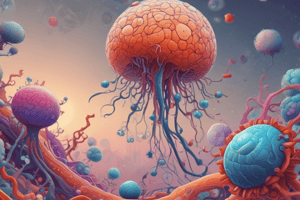Podcast
Questions and Answers
What is the main function of the Golgi apparatus in a cell?
What is the main function of the Golgi apparatus in a cell?
- Processing and modifying proteins and lipids (correct)
- Storing genetic information
- Generating energy for the cell
- Breaking down and recycling cellular waste
What is the purpose of lysosomes in a cell?
What is the purpose of lysosomes in a cell?
- Generating energy for the cell
- Synthesizing proteins
- Breaking down and recycling cellular waste (correct)
- Regulating the movement of materials in and out of the cell
Which type of cell lacks a true nucleus?
Which type of cell lacks a true nucleus?
- Prokaryotic cell (correct)
- Eukaryotic cell
- Plant cell
- Animal cell
What is the primary function of the cytoskeleton in a cell?
What is the primary function of the cytoskeleton in a cell?
What is the process by which cells communicate with each other through signaling molecules?
What is the process by which cells communicate with each other through signaling molecules?
What is the term for the movement of molecules across the cell membrane?
What is the term for the movement of molecules across the cell membrane?
What is the site of cellular respiration in a cell?
What is the site of cellular respiration in a cell?
What is the term for a group of similar cells that perform a specific function?
What is the term for a group of similar cells that perform a specific function?
Flashcards are hidden until you start studying
Study Notes
Cell Structure
- Plasma Membrane: a semi-permeable membrane that separates the cell from its environment, regulating the movement of materials in and out of the cell.
- Cytoplasm: a jelly-like substance inside the cell where metabolic reactions occur.
- Nucleus: the control center of the cell where DNA is stored.
- Mitochondria: the site of cellular respiration, responsible for generating energy for the cell.
- Ribosomes: small organelles responsible for protein synthesis.
- Lysosomes: membrane-bound sacs that contain digestive enzymes, responsible for breaking down and recycling cellular waste.
- Golgi Apparatus: a complex of flattened sacs and tubes that process and modify proteins and lipids.
- Cytoskeleton: a network of filaments that provides structural support, shape, and movement to the cell.
Cellular Processes
- Cell Division: the process by which a cell divides into two daughter cells, including mitosis (division of nucleus) and cytokinesis (division of cytoplasm).
- Photosynthesis: the process by which cells convert light energy into chemical energy, occurring in chloroplasts of plant cells.
- Cell Signaling: the process by which cells communicate with each other through signaling molecules, allowing for coordination and regulation of cellular activities.
- Cellular Transport: the movement of molecules across the cell membrane, including passive transport (diffusion, osmosis) and active transport (carrier proteins, pumps).
Cellular Organization
- Eukaryotic Cells: cells with a true nucleus and membrane-bound organelles, characteristic of plants, animals, fungi, and protists.
- Prokaryotic Cells: cells without a true nucleus, characteristic of bacteria and archaea.
- Tissue: a group of similar cells that perform a specific function, such as muscle tissue or epithelial tissue.
- Organ: a structure composed of two or more types of tissues that perform a specific function, such as the heart or lungs.
- Organ System: a group of organs that work together to perform a specific function, such as the circulatory system or nervous system.
Cell Structure
- The plasma membrane is semi-permeable, controlling the movement of materials in and out of the cell.
- Cytoplasm is a jelly-like substance inside the cell where metabolic reactions occur.
- The nucleus is the control center of the cell, storing DNA.
- Mitochondria generate energy for the cell through cellular respiration.
- Ribosomes are responsible for protein synthesis.
- Lysosomes contain digestive enzymes, breaking down and recycling cellular waste.
- The Golgi Apparatus processes and modifies proteins and lipids.
- The cytoskeleton provides structural support, shape, and movement to the cell.
Cellular Processes
- Cell division involves mitosis (nuclear division) and cytokinesis (cytoplasmic division).
- Photosynthesis occurs in chloroplasts of plant cells, converting light energy into chemical energy.
- Cell signaling allows cells to communicate with each other through signaling molecules.
- Cellular transport includes passive transport (diffusion, osmosis) and active transport (carrier proteins, pumps).
Cellular Organization
- Eukaryotic cells have a true nucleus and membrane-bound organelles, characteristic of plants, animals, fungi, and protists.
- Prokaryotic cells lack a true nucleus, characteristic of bacteria and archaea.
- Tissue is a group of similar cells that perform a specific function.
- Organs are composed of two or more types of tissues that perform a specific function.
- Organ systems are groups of organs that work together to perform a specific function.
Studying That Suits You
Use AI to generate personalized quizzes and flashcards to suit your learning preferences.




